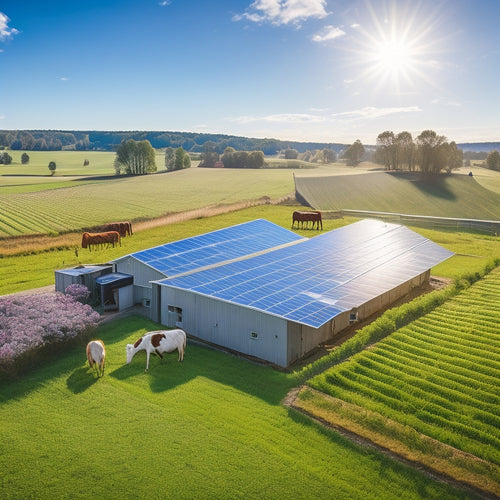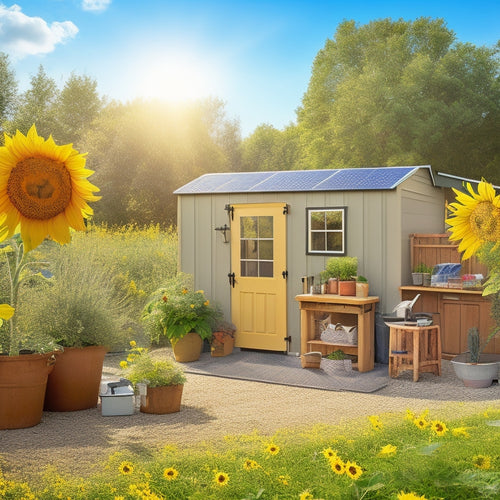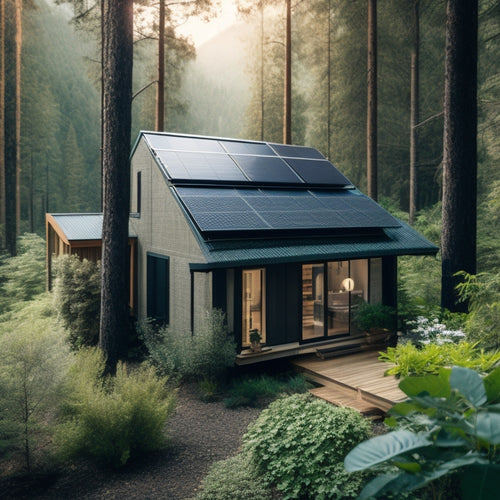
Diy Solar System
Share
By shifting to a DIY solar system, you can instantly reduce your reliance on the grid and start utilizing free energy from the sun, saving you money on electricity bills and greatly decreasing your carbon footprint. With careful design and assessment of local resources, you can maximize energy efficiency and effectiveness. Regular maintenance and energy storage solutions like batteries guarantee a seamless shift to energy independence. As you investigate the world of DIY solar systems, you'll uncover more strategies for optimizing energy collection, reducing consumption, and reaping the benefits of renewable energy - and the more you learn, the closer you'll get to achieving true energy self-sufficiency.
The Essentials
- Achieve energy self-sufficiency by assessing local resources, designing efficient systems, and maximizing energy harvesting and output.
- Select high-quality solar panels, and optimize their placement, angle, and orientation for maximum energy generation.
- Implement energy-efficient practices, such as replacing traditional appliances and using smart home technology, to reduce energy consumption.
- Regular maintenance, including cleaning and performance monitoring, ensures optimal system efficiency and longevity.
- Consider energy storage solutions, scalability, and government incentives when designing and installing a DIY solar system.
Zero Energy Dependency
You'll achieve zero energy dependency by utilizing renewable energy sources, such as solar and wind power, to meet your energy needs.
This change enables energy self-sufficiency, reducing your reliance on the grid and mitigating your carbon footprint.
By leveraging off-grid solar power systems and carefully designing your DIY solar system, you can guarantee a seamless shift to off-grid energy independence.
Renewable Energy Sources
Utilizing renewable energy sources is vital for achieving zero energy dependency in your DIY solar system. By tapping into the power of nature, you'll reduce your reliance on public utilities and enjoy the freedom that comes with sustainable living.
Solar panel technology plays an important role in this process, converting sunlight into electrical energy that can power your home or business. With a solar energy kit, you can generate electricity anywhere with sunlight, and greatly reduce your carbon footprint off-grid solar kits.
Additionally, solar energy systems for homes can provide a simple, sustainable, and long-lasting solution for those looking to save money and minimize their impact on the environment.
When selecting renewable energy sources, consider the resources available in your area. Solar energy is an excellent choice for regions with high sunlight exposure, while wind or hydro power may be more suitable for areas with strong winds or abundant water resources. Geothermal energy, which utilizes heat from the Earth's core, is another viable option.
To maximize the effectiveness of your renewable energy sources, it's important to assess your energy needs and determine the most efficient way to meet them. By doing so, you'll be well on your way to achieving zero energy dependency and enjoying the benefits of sustainable living.
Energy Self Sufficiency
As you strive to break free from reliance on public utilities, achieving energy self-sufficiency becomes a critical milestone in your DIY solar system expedition. This means generating and storing enough energy to power your home, business, or community without relying on the grid.
With the help of off-grid solar solutions Renewable Energy Systems, you can minimize your reliance on traditional grid power and reduce your energy expenses. In addition, embracing alternative energy solutions can provide a reliable alternative for those living in remote areas with limited access to traditional grid power.
To achieve this, you'll need to verify your solar panel maintenance is regular and thorough, optimizing energy production. Energy storage solutions like batteries will help you store excess energy for later use.
Adopting a sustainable lifestyle and embracing off-grid living will also reduce your energy consumption. Government incentives and community solar programs can provide financial support for your DIY solar system.
By choosing eco-friendly practices and embracing energy independence, you'll minimize your environmental impact. Furthermore, advancements in solar technology will continue to improve efficiency and reduce costs.
Lower Electricity Bills Guaranteed
You'll reduce your energy consumption by generating electricity on-site, which directly translates to lower power costs.
By installing a DIY solar system, you'll cut your reliance on the grid and decrease your energy expenses.
With renewable energy solutions, you can enjoy a significant reduction in your electricity bills.
Additionally, with solar power, you'll be contributing to a more sustainable future and reducing your carbon footprint.
With solar power, you can expect a significant decrease in your electricity bills, guaranteed.
Cut Energy Consumption
Cutting your energy consumption is a crucial step in utilizing the power of your DIY solar system, and it's important to get it right from the start.
You'll want to identify areas where you can reduce your energy usage, and then implement changes to make your home more energy efficient.
One effective way to do this is by replacing traditional appliances with energy efficient ones.
Look for appliances with the ENERGY STAR label, which indicates they meet energy efficiency standards set by the U.S. Environmental Protection Agency.
You can also consider upgrading to smart home technology, such as smart thermostats and smart lighting systems, which can help you monitor and control your energy usage in real-time.
Additionally, make sure to unplug appliances and electronics when not in use to eliminate standby power consumption.
Reduce Power Costs
By integrating your DIY solar system with energy-efficient habits, you're ready to reduce power costs and enjoy lower electricity bills assured.
You've optimized your energy consumption, now it's time to maximize your solar energy production. Choose the right solar panel types for your system, considering factors like efficiency, durability, and cost. Monocrystalline panels offer high efficiency, while polycrystalline panels provide a more affordable option.
To guarantee a steady energy supply, incorporate energy storage into your system. Battery storage solutions like lithium-ion or lead-acid batteries store excess energy generated during the day for use during the night or on cloudy days.
This way, you can reduce your reliance on the grid and minimize your electricity bills. By combining your DIY solar system with energy-efficient habits and energy storage, you'll be able to reduce your power costs considerably.
With lower electricity bills assured, you'll enjoy the freedom and independence that comes with generating your own clean energy.
Maximum Energy Harvesting
You'll want to optimize your solar panel's energy output to maximize energy harvesting. This involves adjusting the panel's angle and orientation to guarantee it receives the most direct sunlight possible.
To achieve this, it's crucial to take into account the type of photovoltaic cells used in your DIY solar system, as they directly impact energy generation.
Energy Output Optimization
What determines the maximum energy your DIY solar system can harvest from the sun? It's a combination of ideal solar panel placement, efficient energy storage solutions, and regular system maintenance tips.
You'll want to confirm your inverter is running at peak efficiency, and that you've conducted a thorough weather impact analysis to anticipate and adapt to changing conditions. Grid connectivity options and battery lifespan management are also vital considerations.
When it comes to installation, understanding the costs breakdown is essential for making informed decisions. A DIY installation guide can help you steer through the process, but it's also important to have performance monitoring tools in place to track your system's output.
Highest Power Generation
To maximize energy harvesting, one essential factor to take into account is the orientation and tilt of your solar panels. You'll want to position them at an angle that allows them to receive the most direct sunlight possible. This is critical, as even a slight deviation from the ideal angle can considerably reduce energy output.
When it comes to solar panel efficiency, you'll want to choose high-quality panels with a high power output rating. Look for panels with a high wattage per square foot, as these will generate more power in a smaller space.
Additionally, consider investing in energy storage solutions, such as deep-cycle batteries, to store excess energy generated during the day for use at night or during power outages.
Properly configuring your solar panel array and energy storage solutions will enable you to utilize the maximum amount of energy from the sun. By doing so, you'll be able to power your home, appliances, and devices with clean, renewable energy, giving you the freedom to live off the grid.
Assess Your Roof's Orientation
You'll want to determine your roof's angle and direction to maximize energy harvesting. A roof angle between 30 and 40 degrees is ideal, as it allows for peak energy absorption.
Additionally, consider the importance of off-grid energy systems and how they can benefit from proper roof orientation.
You'll also need to identify the direction your roof faces, as a south-facing orientation receives the most sunlight throughout the day.
Roof Angle Matters
Most residential roofs have a pitch between 15 and 40 degrees, and yours likely falls within this range. The roof pitch plays a vital role in determining the best solar alignment for your DIY solar system.
You'll want to assess your roof's angle to guarantee maximum energy harvesting. To do this, measure the vertical rise of your roof in inches over a 12-inch horizontal distance. This will give you the roof's pitch in inches per foot. Then, convert this value to degrees using a pitch-to-degree conversion chart or calculator. For instance, a 4:12 roof pitch translates to an angle of approximately 18.4 degrees.
A roof angle between 30 and 40 degrees is generally considered ideal for solar panels, as it allows for adequate snow shedding and debris removal. However, panels can still be installed on roofs with pitches as low as 15 degrees, albeit with slightly reduced energy output.
Accurately determining your roof's angle will help you enhance your solar system's performance and maximize your energy independence.
Optimal Direction Found
Evaluating your roof's orientation is essential for maximizing energy output from your DIY solar system, as panels installed in the ideal direction can greatly enhance electricity generation.
To determine the best direction, you'll need to analyze your roof's azimuth, which is the compass direction it faces. In the northern hemisphere, a south-facing roof is ideal, as it receives the most direct sunlight exposure throughout the day.
If your roof doesn't face directly south, don't worry – you can still achieve optimal solar panel placement. East- and west-facing roofs can also generate significant energy, although output may be slightly lower.
When analyzing your roof's orientation, consider any obstructions or shading that may affect sunlight exposure. Take note of nearby trees, buildings, or other structures that could cast shadows on your solar panels.
Higher Energy Conversion Rate
You'll want to maximize your solar panel's energy conversion rate to get the most out of your DIY solar system.
Efficient energy harvesting is essential, as it directly impacts the amount of electricity your system produces.
Efficient Energy Harvesting
One key aspect of an efficient DIY solar system is maximizing energy harvesting through a higher energy conversion rate. You can achieve this by selecting high-efficiency solar panel materials that can convert sunlight into electricity at a higher rate.
Additionally, you'll want to take into account energy storage solutions that can store excess energy generated during the day for use at night or on cloudy days. Proper installation techniques, such as tilting and angling your solar panels, can also increase energy harvesting.
Regular maintenance practices, like cleaning your panels, will guarantee peak performance. When integrating your DIY solar system with the grid, you'll need to take into account battery technology and system scalability to guarantee a seamless shift between solar and grid power.
Don't forget to assess the environmental impact of your system and take advantage of financial incentives and government regulations that support renewable energy.
Frequently Asked Questions
How Long Does It Take to Install a DIY Solar System?
When you decide to go solar, you're likely wondering how long the installation process takes. The installation timeline largely depends on the complexity of your system, including the number of system components, such as panels and inverters, you're working with.
Can I Install Solar Panels on a Metal Roof?
You can install solar panels on a metal roof, but make certain the metal roof installation is compatible with solar panels, considering factors like roof material, structure, and coatings to warrant a secure and efficient energy-harvesting system.
Do Solar Panels Work on Cloudy or Rainy Days?
You'll find that solar panels still generate power on cloudy or rainy days, albeit with reduced solar efficiency. While cloudy conditions decrease energy output, you'll still capture some electricity, making solar a reliable choice for your independence.
Can I Add More Panels to My Existing DIY Solar System?
When expanding your renewable energy setup, you'll need to verify new panels are compatible with your existing system. You'll also need to reassess system sizing to optimize performance and avoid potential electrical imbalances.
Are DIY Solar Systems Eligible for Government Incentives?
You can claim tax credits for solar installations, reducing your costs; however, you'll need to ascertain your system meets efficiency standards and complies with local regulations, which may impact the amount of credits you're eligible for.
Final Thoughts
Seize solar supremacy by switching to a DIY solar system. Synchronize your setup to soak up maximum sunbeams, slashing your reliance on the grid. Savvy assessments of your roof's orientation and clever component choices will catapult your energy conversion rates. With precision planning, you'll pocket palpable savings on your power bills, proudly proclaiming your independence from energy monopolies.
Related Posts
-

What Do I Need to Know About Farm Solar Panels
When considering farm solar panels, you need to assess costs, benefits, and technical specifics. Initial investment c...
-

Building an Emergency Backup Solar Power System in 5 Essential Steps
Building an emergency backup solar power system involves five key steps. First, assess your daily energy needs to ide...
-

Off Grid Solar Batteries
As you shift to off-grid living, you'll rely on high-performance solar batteries to store excess energy generated by ...


